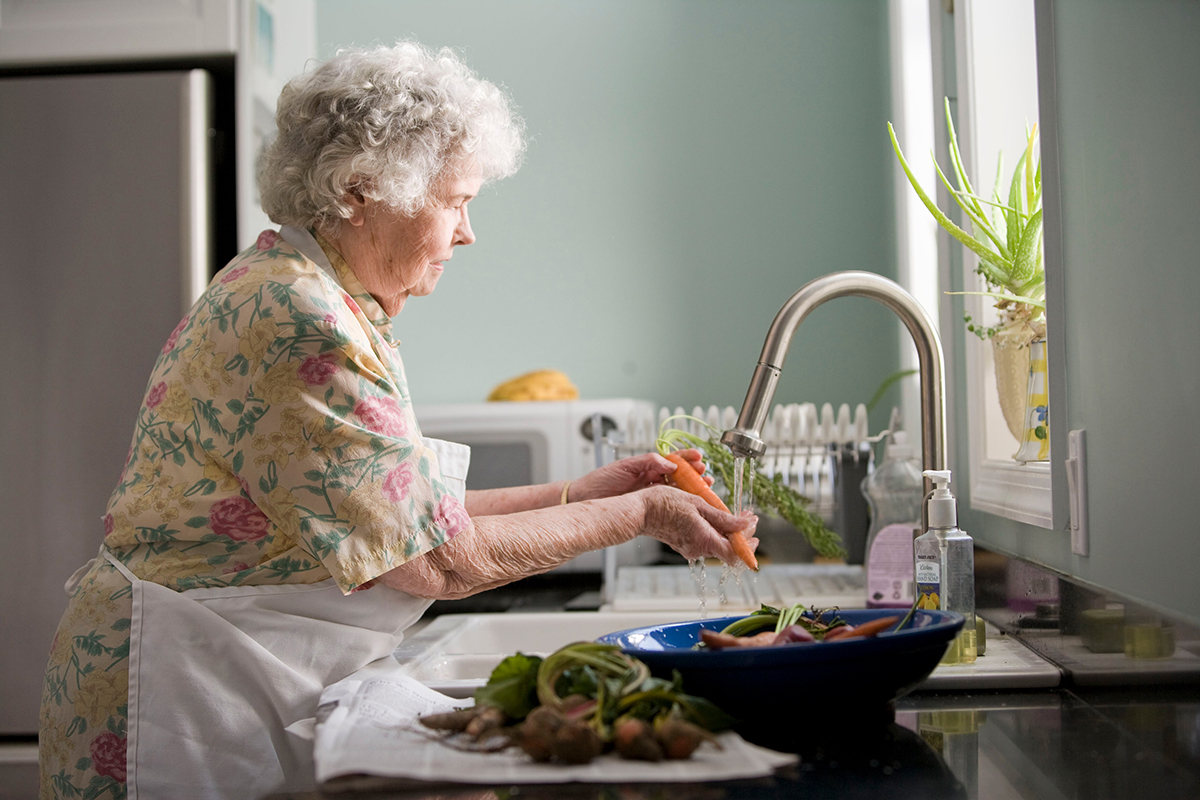According to the Centers for Disease Control and Prevention (CDC) each year 48 million illnesses, 128,000 hospitalizations, and 3,000 deaths in this country can be traced to foodborne pathogens.
We’ve probably all heard our older loved ones comment that they have always (insert poor food storage adage here) and it was fine. However, bacteria have evolved since their youth. There are both more types of bacteria and they are more resistant to the usual elimination methods.
Food sources have become more global. Even fruits and vegetables are coming from other states and other countries. This both increases the number of pathogens that can be picked up between the place of origin and our homes and introduces new bacteria that wouldn’t be in our environment had we shopped locally.
Source: Partnership for Food Safety Education
Who Is At Risk?
Adults aged 65 and older are at a higher risk for hospitalization and death from foodborne illnesses. There are several reasons for this:
- Their gastrointestinal tract holds food for longer, allowing more bacteria to grow.
- Liver and kidneys typically function at a lower level, not clearing bacteria and toxins as efficiently as when they were younger.
- Their stomach may not produce as much bacteria- reducing acid.
- Underlying chronic conditions such as diabetes and cancer increase the susceptibility to foodborne illnesses.Source: FoodSafety.gov
Did You Know?
Flour, regardless of the brand, can contain bacteria that cause disease. Flour is ground from raw grain, which may be bleached, but not usually treated to kill bacteria like E. coli.
The FDA recommends the following precautions:
- Do not eat raw cookie dough, cake mix, batter, or dough that is meant to be cooked.
- Follow instructions for cooking any products containing flour.
- Wash hands and work surfaces thoroughly after contact with dough or flour.
- Chill dough promptly if not baking immediately.Source: Food and Drug Administration
Tips for Safer Food Storage and Handling
You can start practicing safe handling as soon as you choose your foods in the market. Here are some basic tips:
- Separate raw meat, poultry, seafood, and eggs from other foods in your shopping cart, grocery bags, and refrigerator. Use the plastic bags provided in the market (or your own) to further isolate these foods.
- Wash hands and surfaces often. Wash hands for at least 20 seconds before and after handling food.
- Rinse all fruit and vegetables, including those with rinds that won’t be eaten. Never place any food on an uncleaned surface.
- Refrigerate foods promptly in a fridge set to a temperature of 40°F or below. Bacteria that cause food poisoning multiply most quickly between 40°F and 140°F.
- Never let raw meat, poultry, eggs, fish, cooked food, or cut fruits and vegetables sit at room temperature for more than two hours before refrigerating.
- Frozen foods should be kept at a temperature of 0°F or below.
- Do not defrost foods at room temperature. Defrost in the fridge, cold water, or the microwave. Cook immediately once they have been thawed.
It is important to cook food at a temperature that kills the harmful bacteria. A food thermometer should be a staple for any home cook. While foods have a variety of ideal temperatures, a few minimums include:
- Roasts and steaks should be at least 145°F.
- Poultry should be at least 165°F. Check internal temperature at the innermost part of the thigh or wing and the thickest part of the breast.
- Ground meat should be at least 160°F. The process of grinding distributes bacteria. Fish should be at least 145°F and/or until the flesh is opaque and flakes easily with a fork. Eggs should be cooked until the yolk and white are firm.
- When microwaving, stir and rotate to ensure there are no cold spots.
- Sauces and gravies should be brought to a boil when reheating.
- Other leftovers should be heated thoroughly to 165°F.
Best If Used By
The date on your packaged food is to indicate the date by which the food will
be the best flavor and quality. The date when the food is “bad” can be anywhere from days to months beyond that. Unfortunately, there areno universal rules for food dating. If you have questions or concerns about the quality, safety or labeling of the foods you buy, reach out to the company directly.
Source: Food and Drug Administration






